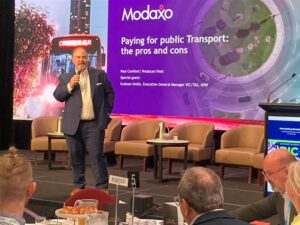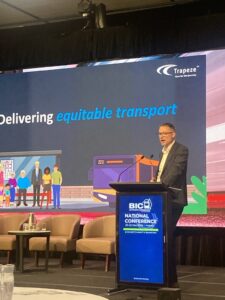Resource Hub
BIC 2024 conference wrap-up
Published December 19, 2024 in Blog
Global public transport influencer Paul Comfort added a celebrity touch to this year’s BIC conference which was located beside the historic port at the heart of Hobart, Tasmania.
Paul is a broadcaster, author, and Modaxo leader who presents the Transit Unplugged TV and podcast shows. The hall was packed for both of his appearances on stage, and he was also spotted outside the venue recording an interview with Metro Tasmania CEO, Katie Cooper, in the spring sunshine.
With David Eason invited to address BIC for the second successive year and Trapeze Bus sponsoring the hydration stations, our team enjoyed making a high-profile contribution.
It was no surprise that decarbonisation, ZEBs, and alternative energy sources were among the most discussed issues in Hobart. Many speakers, including Paul and David, considered aspects of sustainability and it was also a popular topic during our conversations with delegates.
Couldn’t make it to Hobart? Read this blog to catch up on some of the highlights.
Trust, incentivisation, and franchising are contract keys
The Future Contracts session was a highlight of the first day, with leaders from the major operators sharing their perspectives.
Kinetic Group CEO, Michael Sewards, compared Australia’s emphasis on penalties with the level of incentivisation in other markets. “In London, up to fifteen per cent of our contract value is obtained through incentives, and we benefit from real-time abatement solutions where the regulator and operator talk on a daily basis about disruptions and appropriate adjustments.”
Operators were encouraged to focus on things they can control by Keolis Downer CEO of Bus, Jay Zmijewski. “During my time in Auckland, on time running KPIs were weighted heavily upon the shift’s first trip, because the operator’s best chance for success is having a well-trained driver arriving at the first stop on time.” He also recommended KPIs that consider the stresses faced by drivers trying to reach key timing points at the correct intervals.
When asked if Australia can find contractual arrangements that suit all operators Transit Systems People and Culture General Manager, Tanya Smith, said the industry can achieve an effective and equitable franchising model. “It is important to recognise that large operators bring economies of scale, robust infrastructure, and a culture of innovation drawn from operating in multiple countries.”
She highlighted the ability of larger organisations to navigate complex legal environments such as Fair Work legislation, and credited smaller contractors for providing their communities with a personalised level of service. Tanya also proposed that success in franchising will be achieved through long term partnerships between operators, government, and suppliers. “Over the past thirty years Australia’s bus sector has evolved towards a franchise model – we need to build upon this.”
Global transport influencer Paul Comfort’s view from the USA
Paul Comfort is Senior Vice President and Chief Customer Officer at Modaxo, the global collective of transport technology companies which includes Trapeze. As a popular speaker who has addressed conferences around the world, he brought a wealth of knowledge to the BIC stage.
 Paul’s keynote address at the welcome breakfast considered the pros and cons of paying for public transport. This was particularly topical given Tasmania’s half-price fare initiative, Queensland’s 50 cent flat rate, and the USA’s growing fare-free transport trend.
Paul’s keynote address at the welcome breakfast considered the pros and cons of paying for public transport. This was particularly topical given Tasmania’s half-price fare initiative, Queensland’s 50 cent flat rate, and the USA’s growing fare-free transport trend.
Paul’s arguments in favour of fare cuts included lower costs-per-passenger, shorter dwell times, less stress for drivers, and the potential for short term ridership growth. He compared these with considerable taxpayer costs, the uneven benefits of a flat rate, the danger of devaluing public transport, and the challenge of reintroducing higher fares.
He concluded by saying that “service quality is the main barrier to public transport ridership” so lower fares will be more effective when combined with technology that enhances passenger experience. “We should focus on delivering headway services, real-time arrival information, journey optimisation, connected multimodal services, and integration with community transport.”
On the conference’s second day Paul was joined on stage by Mark Peters, General Manager of Operations for Transit Systems. They shared perspectives from the USA and Australia on the trends and transformations that each has seen in their local markets including ZEB fleets and future fuels.
David Eason on EVs, horizon scheduling, and a new opportunity
During the Adapt session Trapeze’s Head of Enterprise Solutions, David Eason, began by discussing our sector’s EV transformation and the key role for central Despatch solutions, such as TIMS, as the information hub that informs and executes EV charging plans.
 He also considered ways to resolve the complex horizon scheduling challenge that EV fleets have created. “Where previously the optimisation problem only included variables such as bus assets and driver resources, now we must include real time refuelling costs. This presents new opportunities to schedule activities over multiple days – or even over a week – to incorporate refuelling time and costs as part of achieving maximum commercial efficiency.”
He also considered ways to resolve the complex horizon scheduling challenge that EV fleets have created. “Where previously the optimisation problem only included variables such as bus assets and driver resources, now we must include real time refuelling costs. This presents new opportunities to schedule activities over multiple days – or even over a week – to incorporate refuelling time and costs as part of achieving maximum commercial efficiency.”
“The emergence of new technology platforms, combined with recent regulatory reforms, has opened up Australia’s community transport space. Bus operators can now simultaneously enhance their service offerings, meet the transport needs of the aging population, and solve the first and last-mile challenge for passengers.”
The traditional fixed route approach works best when services are well aligned with demand, avoiding inefficient or unprofitable kilometres. David suggested that applying flexibility to these fixed routes ensures that some buses only run when demand exists, which passengers can indicate in advance using an app such as Routematch or Novus. He noted that Transdev is already investing in transport tech startup Liftango.
Operators using technology to blend fixed-route and community transport services could potentially access subsidised funding, optimise their off-peak fleet usage, and improve passenger experiences.
He added: “This model promotes equitable transport because the first/last mile is where we find the most diverse group of passengers. By catering to seniors, commuters, and students on shared journeys, operators can even contribute to greater social cohesion in local communities.”
Let’s talk solutions
David Eason and the Trapeze team enjoyed a productive few days in Hobart as conversations continued about our TIMS, Austrics, community transport, and ITS software.
Did you find the solution your organisation is looking for at BIC? Our bus technology experts can help you to achieve your objectives, so contact us today to find out more.
Mode of Transport
Bus
Solutions
Bus Enterprise Resource Planning (TIMS), Bus Planning and Scheduling (Austrics), Intelligent Transport Systems
Meet the author
Trapeze Group